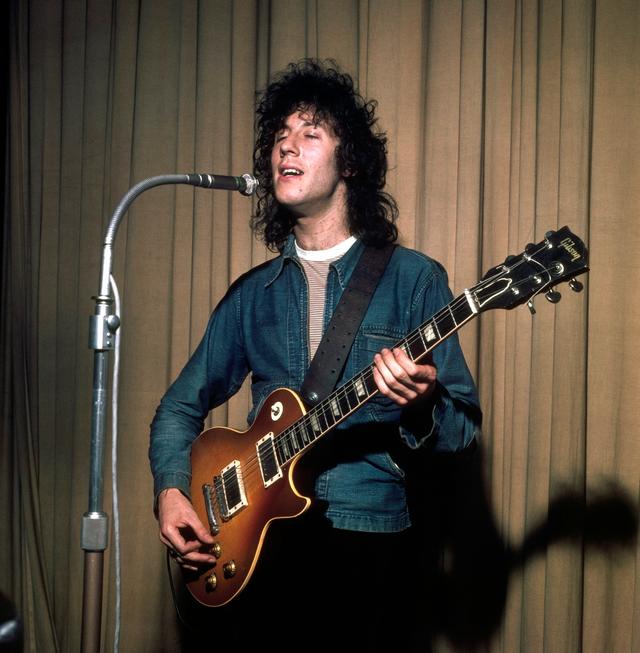R.I.P., Peter Green, Co-Founder of Fleetwood Mac

A true rock legend has left us: word has reached Rhino HQ that Peter Green, the guitar god who left his role as one of John Mayall’s Bluesbreakers to form Fleetwood Mac, died yesterday at the age of 73.
“The Warner Music family is incredibly saddened to hear the news of Peter Green’s passing. The influential guitar virtuoso, gifted singer-songwriter, and co-founder of Fleetwood Mac made an indelible contribution to the evolution of rock music. Legions of artists have been inspired by his signature musicianship and such Green-penned, revolutionary classics as ‘Albatross,’ ‘Black Magic Woman,’ ‘Oh Well,’ and ‘The Green Manalishi (With The Two Prong Crown)’. His Rock & Roll Hall of Fame career included a fruitful time with Reprise Records that yielded both the landmark Fleetwood Mac album, THEN PLAY ON, and Green’s first solo album, the experimental masterpiece, THE END OF THE GAME. We offer his family, bandmates, and fans our deepest condolences in this difficult time. Rest in Peace, Peter.”
– Kevin Gore, Warner Music Group President Global Catalog, Recorded Music
Born Peter Allen Greenbaum in Bethnal Green, London on October 29, 1946, the man who would eventually shed the final four letters of his last name and become simply Peter Green learned his first guitar chords from his brother Michael. By the time he was 11 years old, however, Peter was teaching himself, and less than half a decade later he was officially a professional musician, playing in such bands as – in chronological order – Bobby Dennis and the Dominoes, the Muskrats, the Tridents, and Peter B’s Looners. The “Peter B” was future Camel founder Peter Bardens, and in addition to playing alongside Bardens, the Looners not only took him into a recording studio for the first time (they recorded a cover of “If You Wanna Be Happy” backed with “Jodrell Blues”) but also teamed him for the first time with drummer Mick Fleetwood.
To back up for a moment, it’s important to mention that just prior to joining the Looners, Green had a very important four-gig stint filling in for Eric Clapton in John Mayall’s Bluesbreakers, doing well enough during this outing that when Clapton left for greener pastures, the Bluesbreakers promptly became greener as a result, with Peter stepping in to fill Eric’s shoes. Of course, this meant that he had to bail out of Bardens’ band, but let’s face it: it worked out best for all parties concerned in the end.
But now we return to the key moment we mentioned in the opening paragraph: when Green left the Bluesbreakers behind to form his own band. What’s funny is that the initial lineup of Fleetwood Mac featured a Fleetwood, but it did not include a Mac: Green and Mick so wanted John McVie to join them – along with Jeremy Spencer – in their new musical endeavor that they named the band “Fleetwood Mac” to help sway him to join, but McVie couldn’t bring himself to throw away his steady income as a Bluesbreaker. As such, the band moved forward with future Savoy Brown bassist Bob Brunning, although Green and Fleetwood remained so steadfast in their desire to have McVie in the band that Brunning was effectively told, “When John changes his mind, you’re out.” (Spoiler alert: within a few weeks, Brunning was out.)
Peter Green’s Fleetwood Mac featuring Jeremy Spencer, as the band was originally called before snipping off the excess material, found fame almost immediately, with their self-titled 1968 album hitting #4 and remaining in the UK Albums chart for over a year. Songs like “Albatross,” “Oh Well,” “Man of the World,” and “The Green Manalishi” became top-10 UK hits for Fleetwood Mac – “Albatross” was actually a chart-topper – and one of Green’s songs also became a substantial hit for Santana: “Black Magic Woman,” hitting #4 on the Billboard Hot 100. In addition, the band’s second album, 1968’s MR. WONDERFUL, hit #10 on the UK Albums chart, providing that Fleetwood Mac was no flash in the pan.
By 1969, however, Green had begun to experiment heavily with LSD, and while Fleetwood Mac’s album THEN PLAY ON, which came out in September of that year, provided the band with a third consecutive top-10 album, it was clear that Green’s mindset was no longer meshing with his bandmates the way it once had. As a result, Green parted ways with the band after Fleetwood Mac’s performance on May 20, 1970, and by December he’d released his debut solo album, an experimental LP entitled THE END OF THE GAME, featuring pianist Zoot Money, keyboardist Nick Buck, bassist Alex Dmochowski, and drummer Godfrey McLean.
Green continued to perform and record, collaborating on several occasions with Mick Fleetwood, and eventually started the Peter Green Splinter Group, a musical entity which released several albums during the 1990s and early 2000s. Perhaps his most high-profile collaboration of his later career came in 2003, when he contributed to Peter Gabriel’s UP album.
Green’s contributions to music will not soon be forgotten, because no matter what else he may have done during his career, he was responsible for starting one of the most popular rock bands of all time. Without Peter Green, there would be no Fleetwood Mac, and for that millions upon millions of music fans will forever be grateful.
Rest in peace, Peter.